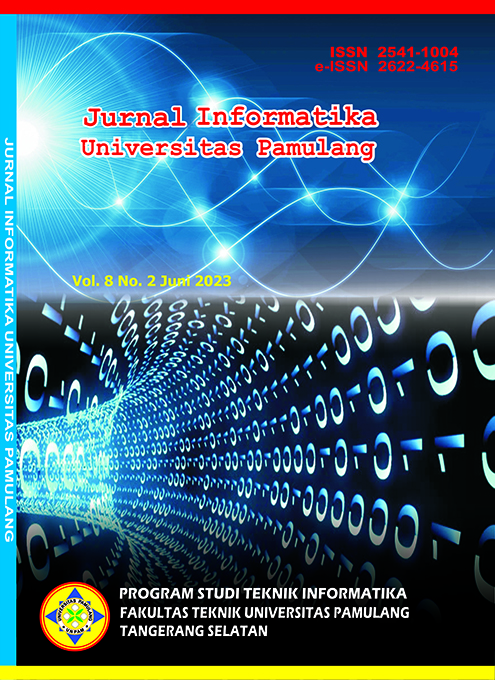Sistem Klasifikasi Berita Menggunakan Metode Text Mining pada Website Pusat Kegiatan Belajar Masyarakat
DOI:
https://doi.org/10.32493/informatika.v8i2.24788Keywords:
Classification System, Text mining, Stemming Algorithm, TF-IDF Algorithm, PKBMAbstract
The use of information systems via websites is not uncommon in this current era. This is because the importance of information quality can affect trust, credibility of an organization, and often used as a promotional media. However, the problem arises when there are increasing numbers of news to be informed, which becomes a problem for web managers. Therefore, a faster method and proper news classification system is needed to avoid future problems. Thus, this research uses the text mining method and pure Term Frequency algorithm to calculate the weight of each word, in order to determine which category the news belongs to automatically. To simplify the system design process, Unified Modeling Language (UML) and PIECES analysis are used to analyze the impact factors that will arise later. Based on the results of the classification system testing, it has been able to provide solutions to categorize information in PKBM, even though there are many news articles with different categories.References
Berezina, K., Bilgihan, A., Cobanoglu, C., & Okumus, F. 2016. Understanding satisfied and dissatisfied hotel customers: text mining of online hotel reviews. Journal of Hospitality Marketing & Management, 25 (1), 1–24.
Bhirawa, C.L. & Puryono, D.A., 2017. Rancang Bangun Aplikasi Graduation News Motivasi Berkreasi Untuk Warga Belajar PKBM Berbasis Android. Indonesian Journal on Networking and Security, 6(3), pp.8–15.
Deolika, A., Kusrini, K., & Luthfi, E. T. (2019). Analisis Pembobotan Kata Pada Klasifikasi Text Mining. (JurTI) Jurnal Teknologi Informasi, 3(2), 179-184.
Faula Azmie, M., 2015. Manajemen Pengelolaan Portal Berita Www.Goriau.Com Dalam Menarik Minat Baca Pada Media Sosial. Jom FISIP, 2(1), pp.1–15.
Gao, X., Tan, R., & Li, G, 2020. Research on text mining of material science based on natural language processing. In IOP conference series: materials science and engineering (Vol. 768, No. 7, p. 072094). IOP Publishing.
KBBI. 2021 Kamus Besar Bahasa Indonesia. [Online]: Available : https://kbbi.web.id/berita
Maarif, A.A., 2015. Penerapan Algoritma TF-IDF untuk Pencarian Karya Ilmiah, (5), p.1-4.
Novitasari, D., 2016. Perbandingan Algoritma Stemming Porter Denganarifin Setiono Untuk Menentukan Tingkat Ketepatan Kata Dasar. , 1(2), pp.193–202.
Raharjo, S. & Winarko, E., 2014. Klasterisasi, klasifikasi dan peringkasan teks berbahasa indonesia. Kommit 2014, 8, pp.391–401.
Thaha, A. R., & Aziz, F. 2020. Penambangan Teks Pada Tujuan Wisata di Bandung Raya (Studi Kasus: Tangkuban Perahu dan Kawah Putih). Jurnal Sekretaris dan Administrasi Bisnis, 4(2), 146-156.
Yulaelawati, E., 2012. Standar Dan Prosedur Penyelenggaraan Pusat Kegiatan Belajar Masyarakat (PKBM).Jurnal Akrab , 7-50.
Downloads
Published
Issue
Section
License
Authors who publish with this journal agree to the following terms:
- Authors retain copyright and grant the journal right of first publication with the work simultaneously licensed under a Creative Commons Attribution-NonCommercial 4.0 International (CC BY-NC 4.0) that allows others to share the work with an acknowledgement of the work's authorship and initial publication in this journal.
- Authors are able to enter into separate, additional contractual arrangements for the non-exclusive distribution of the journal's published version of the work (e.g., post it to an institutional repository or publish it in a book), with an acknowledgement of its initial publication in this journal.
- Authors are permitted and encouraged to post their work online (e.g., in institutional repositories or on their website) prior to and during the submission process, as it can lead to productive exchanges, as well as earlier and greater citation of published work (See The Effect of Open Access).
Jurnal Informatika Universitas Pamulang have CC-BY-NC or an equivalent license as the optimal license for the publication, distribution, use, and reuse of scholarly work.
In developing strategy and setting priorities, Jurnal Informatika Universitas Pamulang recognize that free access is better than priced access, libre access is better than free access, and libre under CC-BY-NC or the equivalent is better than libre under more restrictive open licenses. We should achieve what we can when we can. We should not delay achieving free in order to achieve libre, and we should not stop with free when we can achieve libre.
Jurnal Informatika Universitas Pamulang is licensed under a Creative Commons Attribution-NonCommercial 4.0 International (CC BY-NC 4.0)
YOU ARE FREE TO:
- Share : copy and redistribute the material in any medium or format
- Adapt : remix, transform, and build upon the material for any purpose, even commercially.
- The licensor cannot revoke these freedoms as long as you follow the license terms





